LL5052 Law of Evidence Coursework: Analyzing Evidence in Theft Case
VerifiedAdded on 2022/12/28
|12
|4065
|92
Case Study
AI Summary
This case study provides a legal analysis of the admissibility of evidence in a theft case involving Rishi, an auxiliary nurse accused of stealing PPE from Flixton Nightingale Hospital. The analysis covers various pieces of evidence, including masks found in Rishi's bag, PPE found at his flat, statements from police interviews, Dr. Hancock's hearsay testimony, and evidence from other hospitals. The study examines the admissibility of each piece of evidence under the Law of Evidence, considering factors such as direct vs. hearsay evidence, the impact of unlawful searches, and the requirements of the Police and Criminal Evidence Act (PACE). It also addresses the measures taken under English law to protect defendants from miscarriages of justice arising from false identification, referencing relevant case law. The document is available on Desklib, which provides students with a range of study tools and solved assignments.
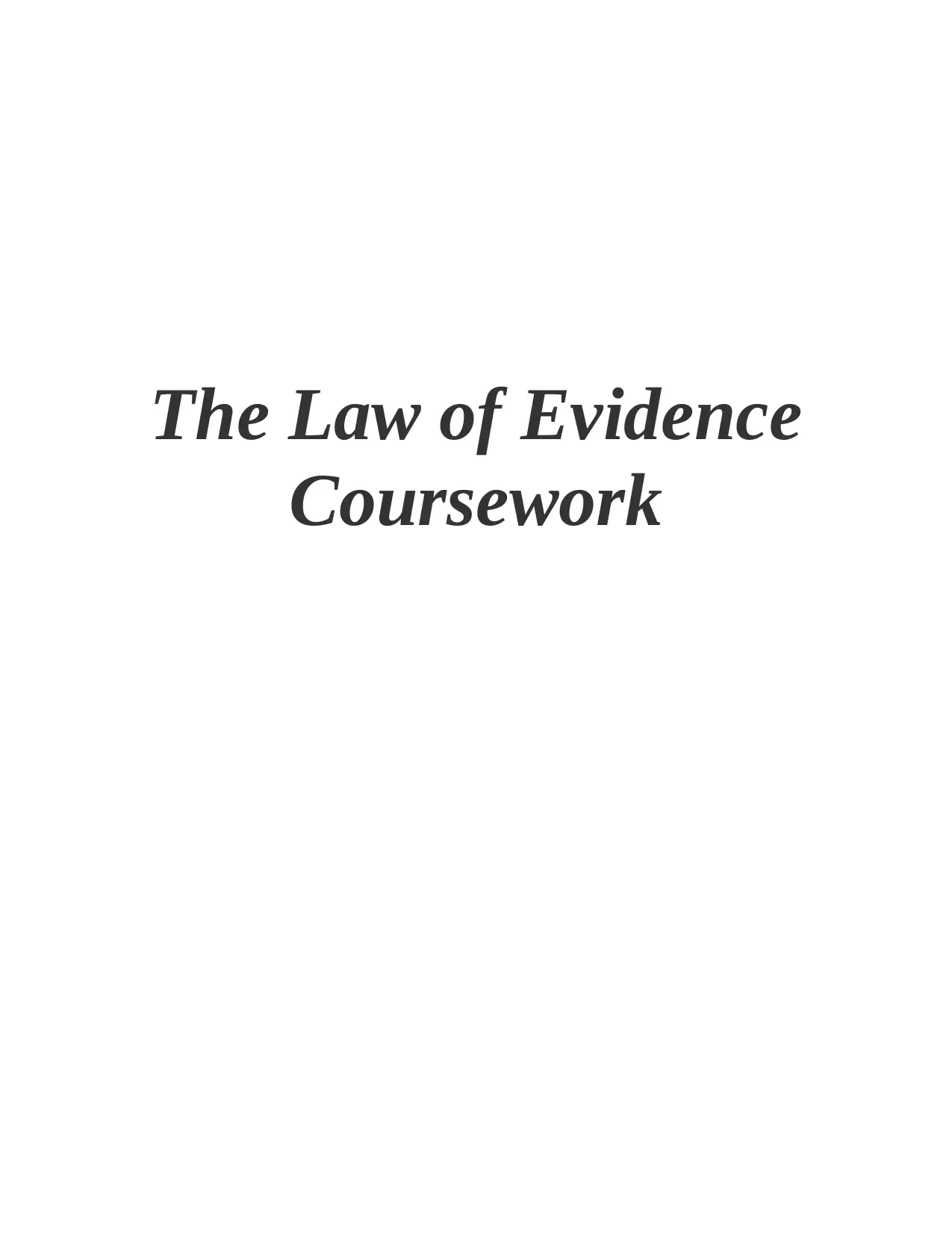
The Law of Evidence
Coursework
Coursework
Paraphrase This Document
Need a fresh take? Get an instant paraphrase of this document with our AI Paraphraser
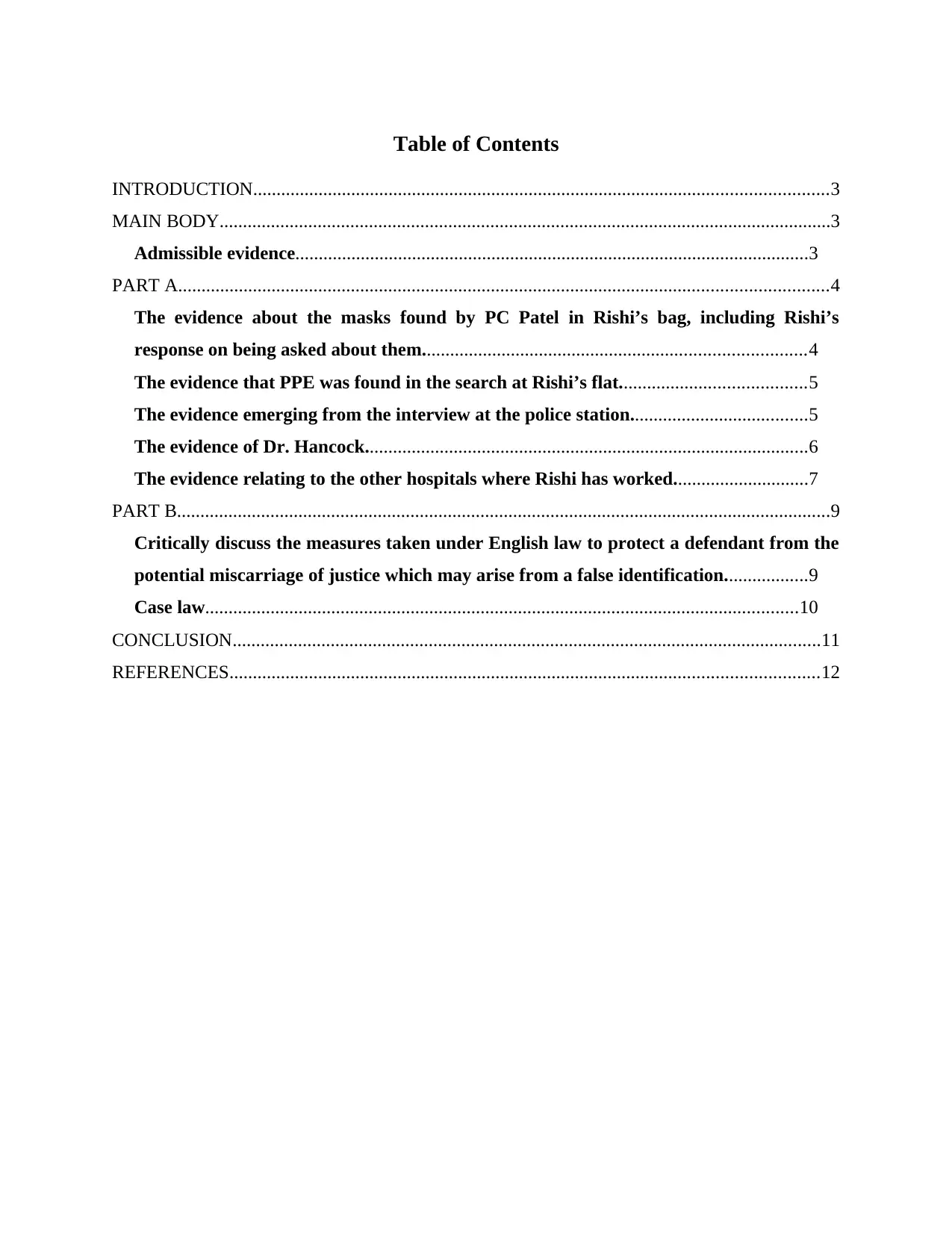
Table of Contents
INTRODUCTION...........................................................................................................................3
MAIN BODY...................................................................................................................................3
Admissible evidence..............................................................................................................3
PART A...........................................................................................................................................4
The evidence about the masks found by PC Patel in Rishi’s bag, including Rishi’s
response on being asked about them..................................................................................4
The evidence that PPE was found in the search at Rishi’s flat........................................5
The evidence emerging from the interview at the police station......................................5
The evidence of Dr. Hancock...............................................................................................6
The evidence relating to the other hospitals where Rishi has worked.............................7
PART B............................................................................................................................................9
Critically discuss the measures taken under English law to protect a defendant from the
potential miscarriage of justice which may arise from a false identification..................9
Case law...............................................................................................................................10
CONCLUSION..............................................................................................................................11
REFERENCES..............................................................................................................................12
INTRODUCTION...........................................................................................................................3
MAIN BODY...................................................................................................................................3
Admissible evidence..............................................................................................................3
PART A...........................................................................................................................................4
The evidence about the masks found by PC Patel in Rishi’s bag, including Rishi’s
response on being asked about them..................................................................................4
The evidence that PPE was found in the search at Rishi’s flat........................................5
The evidence emerging from the interview at the police station......................................5
The evidence of Dr. Hancock...............................................................................................6
The evidence relating to the other hospitals where Rishi has worked.............................7
PART B............................................................................................................................................9
Critically discuss the measures taken under English law to protect a defendant from the
potential miscarriage of justice which may arise from a false identification..................9
Case law...............................................................................................................................10
CONCLUSION..............................................................................................................................11
REFERENCES..............................................................................................................................12
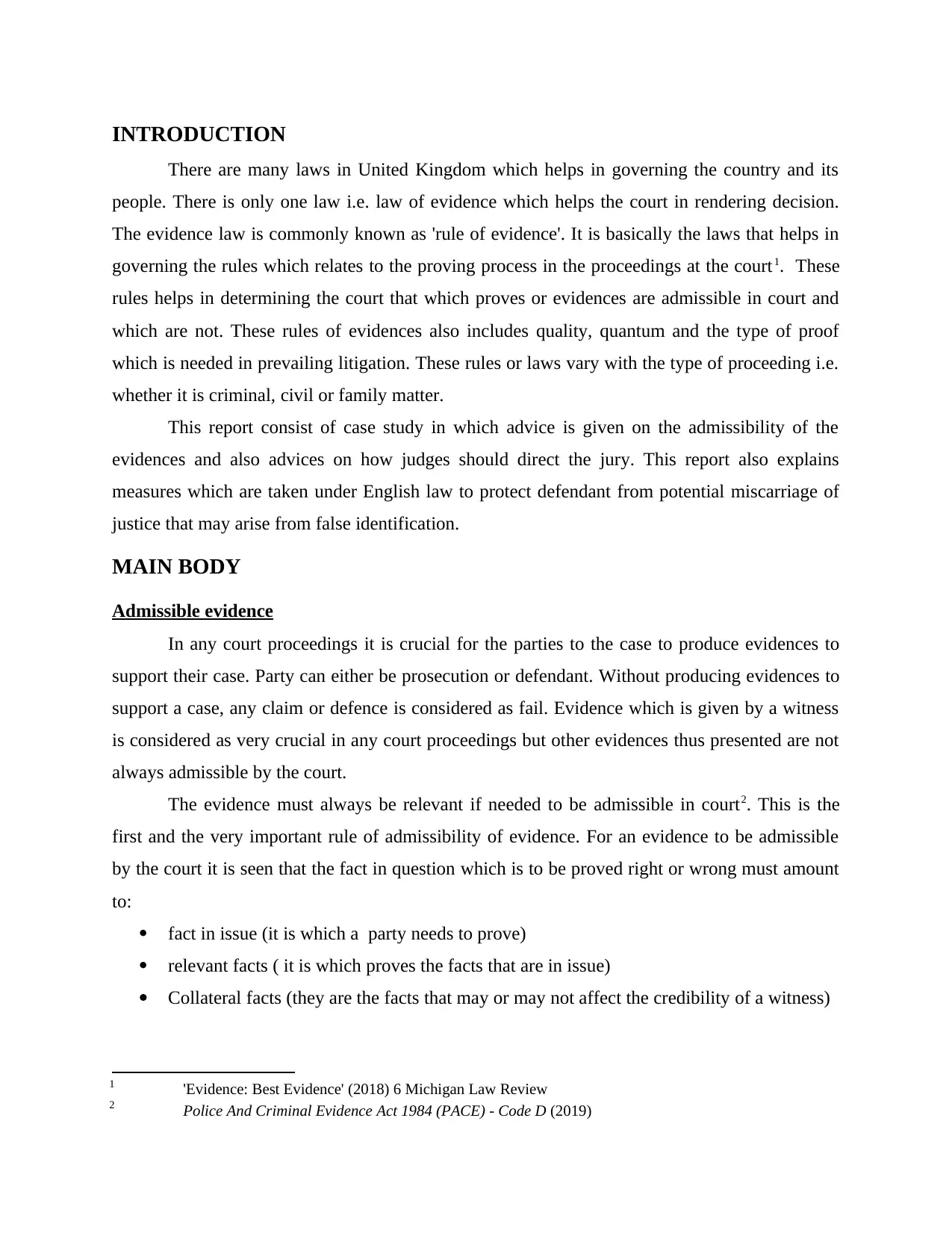
INTRODUCTION
There are many laws in United Kingdom which helps in governing the country and its
people. There is only one law i.e. law of evidence which helps the court in rendering decision.
The evidence law is commonly known as 'rule of evidence'. It is basically the laws that helps in
governing the rules which relates to the proving process in the proceedings at the court1. These
rules helps in determining the court that which proves or evidences are admissible in court and
which are not. These rules of evidences also includes quality, quantum and the type of proof
which is needed in prevailing litigation. These rules or laws vary with the type of proceeding i.e.
whether it is criminal, civil or family matter.
This report consist of case study in which advice is given on the admissibility of the
evidences and also advices on how judges should direct the jury. This report also explains
measures which are taken under English law to protect defendant from potential miscarriage of
justice that may arise from false identification.
MAIN BODY
Admissible evidence
In any court proceedings it is crucial for the parties to the case to produce evidences to
support their case. Party can either be prosecution or defendant. Without producing evidences to
support a case, any claim or defence is considered as fail. Evidence which is given by a witness
is considered as very crucial in any court proceedings but other evidences thus presented are not
always admissible by the court.
The evidence must always be relevant if needed to be admissible in court2. This is the
first and the very important rule of admissibility of evidence. For an evidence to be admissible
by the court it is seen that the fact in question which is to be proved right or wrong must amount
to:
fact in issue (it is which a party needs to prove)
relevant facts ( it is which proves the facts that are in issue)
Collateral facts (they are the facts that may or may not affect the credibility of a witness)
1 'Evidence: Best Evidence' (2018) 6 Michigan Law Review
2 Police And Criminal Evidence Act 1984 (PACE) - Code D (2019)
There are many laws in United Kingdom which helps in governing the country and its
people. There is only one law i.e. law of evidence which helps the court in rendering decision.
The evidence law is commonly known as 'rule of evidence'. It is basically the laws that helps in
governing the rules which relates to the proving process in the proceedings at the court1. These
rules helps in determining the court that which proves or evidences are admissible in court and
which are not. These rules of evidences also includes quality, quantum and the type of proof
which is needed in prevailing litigation. These rules or laws vary with the type of proceeding i.e.
whether it is criminal, civil or family matter.
This report consist of case study in which advice is given on the admissibility of the
evidences and also advices on how judges should direct the jury. This report also explains
measures which are taken under English law to protect defendant from potential miscarriage of
justice that may arise from false identification.
MAIN BODY
Admissible evidence
In any court proceedings it is crucial for the parties to the case to produce evidences to
support their case. Party can either be prosecution or defendant. Without producing evidences to
support a case, any claim or defence is considered as fail. Evidence which is given by a witness
is considered as very crucial in any court proceedings but other evidences thus presented are not
always admissible by the court.
The evidence must always be relevant if needed to be admissible in court2. This is the
first and the very important rule of admissibility of evidence. For an evidence to be admissible
by the court it is seen that the fact in question which is to be proved right or wrong must amount
to:
fact in issue (it is which a party needs to prove)
relevant facts ( it is which proves the facts that are in issue)
Collateral facts (they are the facts that may or may not affect the credibility of a witness)
1 'Evidence: Best Evidence' (2018) 6 Michigan Law Review
2 Police And Criminal Evidence Act 1984 (PACE) - Code D (2019)
⊘ This is a preview!⊘
Do you want full access?
Subscribe today to unlock all pages.

Trusted by 1+ million students worldwide
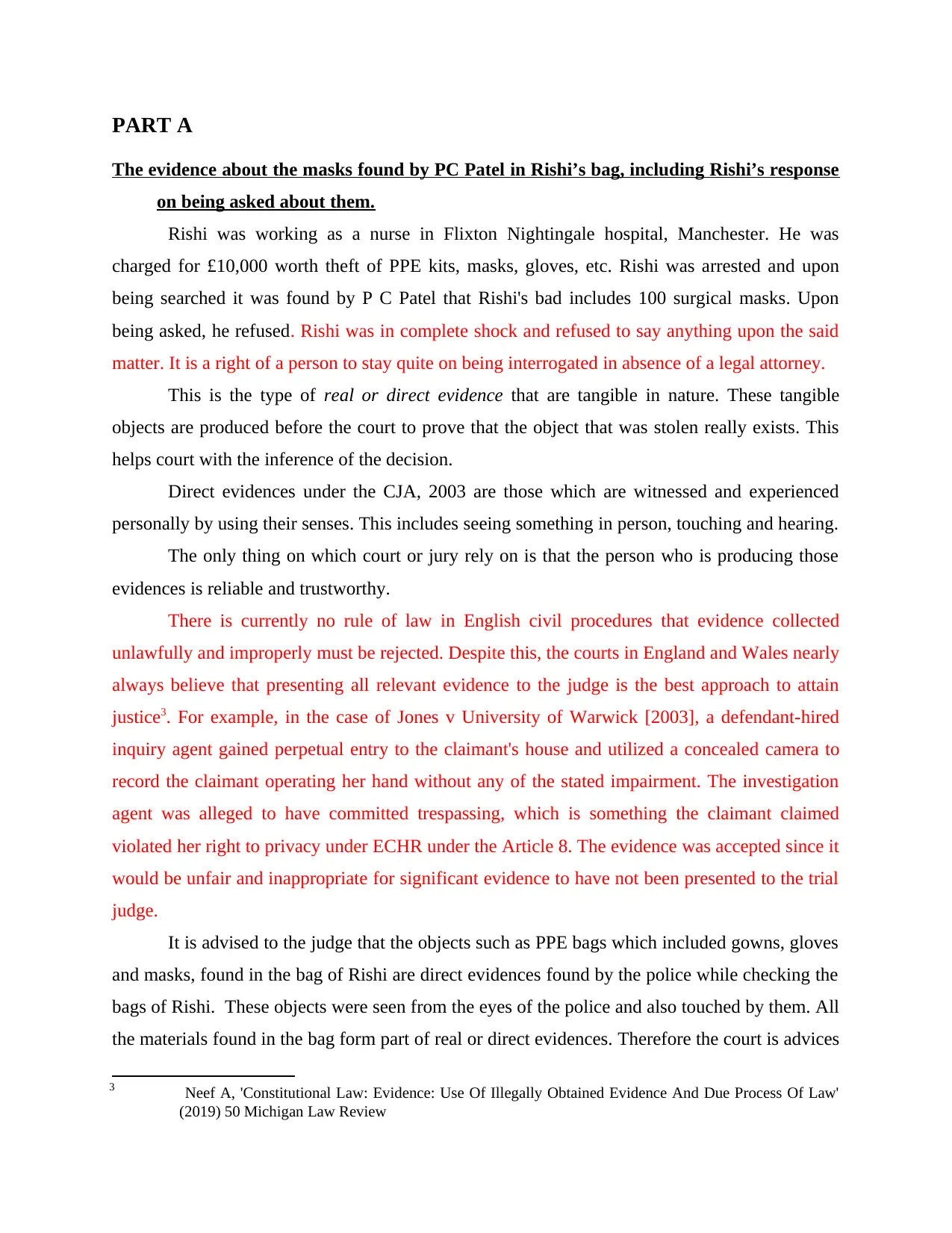
PART A
The evidence about the masks found by PC Patel in Rishi’s bag, including Rishi’s response
on being asked about them.
Rishi was working as a nurse in Flixton Nightingale hospital, Manchester. He was
charged for £10,000 worth theft of PPE kits, masks, gloves, etc. Rishi was arrested and upon
being searched it was found by P C Patel that Rishi's bad includes 100 surgical masks. Upon
being asked, he refused. Rishi was in complete shock and refused to say anything upon the said
matter. It is a right of a person to stay quite on being interrogated in absence of a legal attorney.
This is the type of real or direct evidence that are tangible in nature. These tangible
objects are produced before the court to prove that the object that was stolen really exists. This
helps court with the inference of the decision.
Direct evidences under the CJA, 2003 are those which are witnessed and experienced
personally by using their senses. This includes seeing something in person, touching and hearing.
The only thing on which court or jury rely on is that the person who is producing those
evidences is reliable and trustworthy.
There is currently no rule of law in English civil procedures that evidence collected
unlawfully and improperly must be rejected. Despite this, the courts in England and Wales nearly
always believe that presenting all relevant evidence to the judge is the best approach to attain
justice3. For example, in the case of Jones v University of Warwick [2003], a defendant-hired
inquiry agent gained perpetual entry to the claimant's house and utilized a concealed camera to
record the claimant operating her hand without any of the stated impairment. The investigation
agent was alleged to have committed trespassing, which is something the claimant claimed
violated her right to privacy under ECHR under the Article 8. The evidence was accepted since it
would be unfair and inappropriate for significant evidence to have not been presented to the trial
judge.
It is advised to the judge that the objects such as PPE bags which included gowns, gloves
and masks, found in the bag of Rishi are direct evidences found by the police while checking the
bags of Rishi. These objects were seen from the eyes of the police and also touched by them. All
the materials found in the bag form part of real or direct evidences. Therefore the court is advices
3 Neef A, 'Constitutional Law: Evidence: Use Of Illegally Obtained Evidence And Due Process Of Law'
(2019) 50 Michigan Law Review
The evidence about the masks found by PC Patel in Rishi’s bag, including Rishi’s response
on being asked about them.
Rishi was working as a nurse in Flixton Nightingale hospital, Manchester. He was
charged for £10,000 worth theft of PPE kits, masks, gloves, etc. Rishi was arrested and upon
being searched it was found by P C Patel that Rishi's bad includes 100 surgical masks. Upon
being asked, he refused. Rishi was in complete shock and refused to say anything upon the said
matter. It is a right of a person to stay quite on being interrogated in absence of a legal attorney.
This is the type of real or direct evidence that are tangible in nature. These tangible
objects are produced before the court to prove that the object that was stolen really exists. This
helps court with the inference of the decision.
Direct evidences under the CJA, 2003 are those which are witnessed and experienced
personally by using their senses. This includes seeing something in person, touching and hearing.
The only thing on which court or jury rely on is that the person who is producing those
evidences is reliable and trustworthy.
There is currently no rule of law in English civil procedures that evidence collected
unlawfully and improperly must be rejected. Despite this, the courts in England and Wales nearly
always believe that presenting all relevant evidence to the judge is the best approach to attain
justice3. For example, in the case of Jones v University of Warwick [2003], a defendant-hired
inquiry agent gained perpetual entry to the claimant's house and utilized a concealed camera to
record the claimant operating her hand without any of the stated impairment. The investigation
agent was alleged to have committed trespassing, which is something the claimant claimed
violated her right to privacy under ECHR under the Article 8. The evidence was accepted since it
would be unfair and inappropriate for significant evidence to have not been presented to the trial
judge.
It is advised to the judge that the objects such as PPE bags which included gowns, gloves
and masks, found in the bag of Rishi are direct evidences found by the police while checking the
bags of Rishi. These objects were seen from the eyes of the police and also touched by them. All
the materials found in the bag form part of real or direct evidences. Therefore the court is advices
3 Neef A, 'Constitutional Law: Evidence: Use Of Illegally Obtained Evidence And Due Process Of Law'
(2019) 50 Michigan Law Review
Paraphrase This Document
Need a fresh take? Get an instant paraphrase of this document with our AI Paraphraser
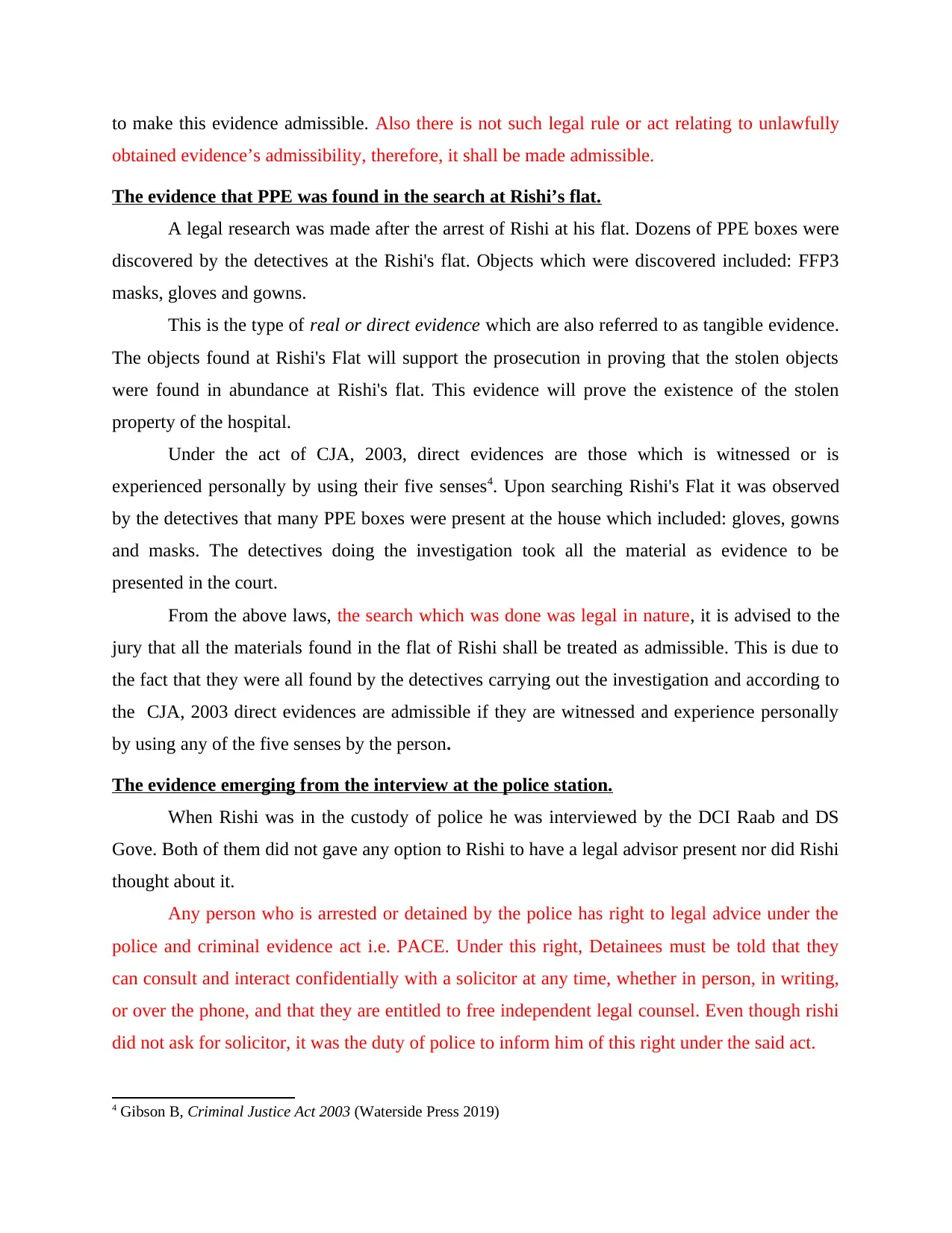
to make this evidence admissible. Also there is not such legal rule or act relating to unlawfully
obtained evidence’s admissibility, therefore, it shall be made admissible.
The evidence that PPE was found in the search at Rishi’s flat.
A legal research was made after the arrest of Rishi at his flat. Dozens of PPE boxes were
discovered by the detectives at the Rishi's flat. Objects which were discovered included: FFP3
masks, gloves and gowns.
This is the type of real or direct evidence which are also referred to as tangible evidence.
The objects found at Rishi's Flat will support the prosecution in proving that the stolen objects
were found in abundance at Rishi's flat. This evidence will prove the existence of the stolen
property of the hospital.
Under the act of CJA, 2003, direct evidences are those which is witnessed or is
experienced personally by using their five senses4. Upon searching Rishi's Flat it was observed
by the detectives that many PPE boxes were present at the house which included: gloves, gowns
and masks. The detectives doing the investigation took all the material as evidence to be
presented in the court.
From the above laws, the search which was done was legal in nature, it is advised to the
jury that all the materials found in the flat of Rishi shall be treated as admissible. This is due to
the fact that they were all found by the detectives carrying out the investigation and according to
the CJA, 2003 direct evidences are admissible if they are witnessed and experience personally
by using any of the five senses by the person.
The evidence emerging from the interview at the police station.
When Rishi was in the custody of police he was interviewed by the DCI Raab and DS
Gove. Both of them did not gave any option to Rishi to have a legal advisor present nor did Rishi
thought about it.
Any person who is arrested or detained by the police has right to legal advice under the
police and criminal evidence act i.e. PACE. Under this right, Detainees must be told that they
can consult and interact confidentially with a solicitor at any time, whether in person, in writing,
or over the phone, and that they are entitled to free independent legal counsel. Even though rishi
did not ask for solicitor, it was the duty of police to inform him of this right under the said act.
4 Gibson B, Criminal Justice Act 2003 (Waterside Press 2019)
obtained evidence’s admissibility, therefore, it shall be made admissible.
The evidence that PPE was found in the search at Rishi’s flat.
A legal research was made after the arrest of Rishi at his flat. Dozens of PPE boxes were
discovered by the detectives at the Rishi's flat. Objects which were discovered included: FFP3
masks, gloves and gowns.
This is the type of real or direct evidence which are also referred to as tangible evidence.
The objects found at Rishi's Flat will support the prosecution in proving that the stolen objects
were found in abundance at Rishi's flat. This evidence will prove the existence of the stolen
property of the hospital.
Under the act of CJA, 2003, direct evidences are those which is witnessed or is
experienced personally by using their five senses4. Upon searching Rishi's Flat it was observed
by the detectives that many PPE boxes were present at the house which included: gloves, gowns
and masks. The detectives doing the investigation took all the material as evidence to be
presented in the court.
From the above laws, the search which was done was legal in nature, it is advised to the
jury that all the materials found in the flat of Rishi shall be treated as admissible. This is due to
the fact that they were all found by the detectives carrying out the investigation and according to
the CJA, 2003 direct evidences are admissible if they are witnessed and experience personally
by using any of the five senses by the person.
The evidence emerging from the interview at the police station.
When Rishi was in the custody of police he was interviewed by the DCI Raab and DS
Gove. Both of them did not gave any option to Rishi to have a legal advisor present nor did Rishi
thought about it.
Any person who is arrested or detained by the police has right to legal advice under the
police and criminal evidence act i.e. PACE. Under this right, Detainees must be told that they
can consult and interact confidentially with a solicitor at any time, whether in person, in writing,
or over the phone, and that they are entitled to free independent legal counsel. Even though rishi
did not ask for solicitor, it was the duty of police to inform him of this right under the said act.
4 Gibson B, Criminal Justice Act 2003 (Waterside Press 2019)
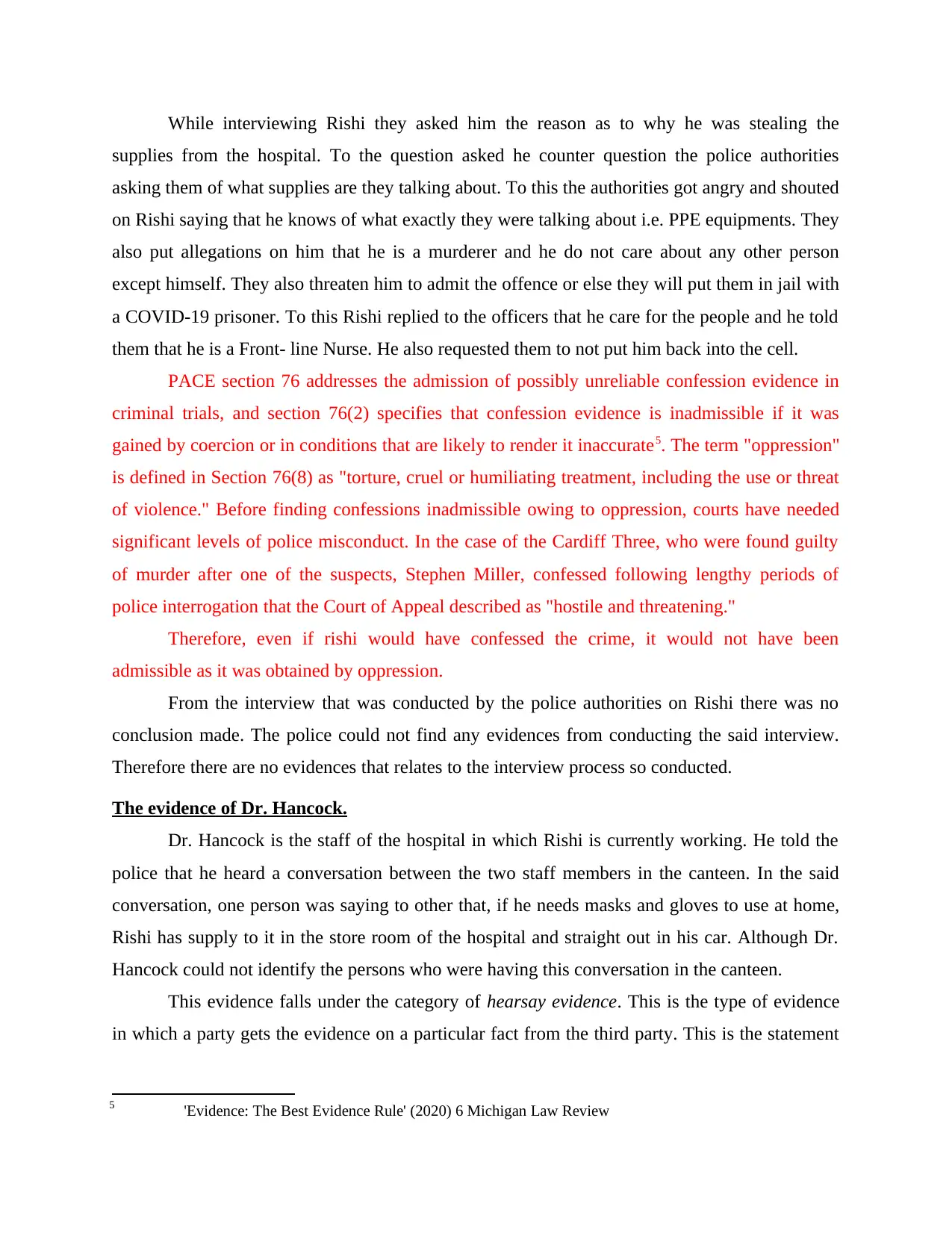
While interviewing Rishi they asked him the reason as to why he was stealing the
supplies from the hospital. To the question asked he counter question the police authorities
asking them of what supplies are they talking about. To this the authorities got angry and shouted
on Rishi saying that he knows of what exactly they were talking about i.e. PPE equipments. They
also put allegations on him that he is a murderer and he do not care about any other person
except himself. They also threaten him to admit the offence or else they will put them in jail with
a COVID-19 prisoner. To this Rishi replied to the officers that he care for the people and he told
them that he is a Front- line Nurse. He also requested them to not put him back into the cell.
PACE section 76 addresses the admission of possibly unreliable confession evidence in
criminal trials, and section 76(2) specifies that confession evidence is inadmissible if it was
gained by coercion or in conditions that are likely to render it inaccurate5. The term "oppression"
is defined in Section 76(8) as "torture, cruel or humiliating treatment, including the use or threat
of violence." Before finding confessions inadmissible owing to oppression, courts have needed
significant levels of police misconduct. In the case of the Cardiff Three, who were found guilty
of murder after one of the suspects, Stephen Miller, confessed following lengthy periods of
police interrogation that the Court of Appeal described as "hostile and threatening."
Therefore, even if rishi would have confessed the crime, it would not have been
admissible as it was obtained by oppression.
From the interview that was conducted by the police authorities on Rishi there was no
conclusion made. The police could not find any evidences from conducting the said interview.
Therefore there are no evidences that relates to the interview process so conducted.
The evidence of Dr. Hancock.
Dr. Hancock is the staff of the hospital in which Rishi is currently working. He told the
police that he heard a conversation between the two staff members in the canteen. In the said
conversation, one person was saying to other that, if he needs masks and gloves to use at home,
Rishi has supply to it in the store room of the hospital and straight out in his car. Although Dr.
Hancock could not identify the persons who were having this conversation in the canteen.
This evidence falls under the category of hearsay evidence. This is the type of evidence
in which a party gets the evidence on a particular fact from the third party. This is the statement
5 'Evidence: The Best Evidence Rule' (2020) 6 Michigan Law Review
supplies from the hospital. To the question asked he counter question the police authorities
asking them of what supplies are they talking about. To this the authorities got angry and shouted
on Rishi saying that he knows of what exactly they were talking about i.e. PPE equipments. They
also put allegations on him that he is a murderer and he do not care about any other person
except himself. They also threaten him to admit the offence or else they will put them in jail with
a COVID-19 prisoner. To this Rishi replied to the officers that he care for the people and he told
them that he is a Front- line Nurse. He also requested them to not put him back into the cell.
PACE section 76 addresses the admission of possibly unreliable confession evidence in
criminal trials, and section 76(2) specifies that confession evidence is inadmissible if it was
gained by coercion or in conditions that are likely to render it inaccurate5. The term "oppression"
is defined in Section 76(8) as "torture, cruel or humiliating treatment, including the use or threat
of violence." Before finding confessions inadmissible owing to oppression, courts have needed
significant levels of police misconduct. In the case of the Cardiff Three, who were found guilty
of murder after one of the suspects, Stephen Miller, confessed following lengthy periods of
police interrogation that the Court of Appeal described as "hostile and threatening."
Therefore, even if rishi would have confessed the crime, it would not have been
admissible as it was obtained by oppression.
From the interview that was conducted by the police authorities on Rishi there was no
conclusion made. The police could not find any evidences from conducting the said interview.
Therefore there are no evidences that relates to the interview process so conducted.
The evidence of Dr. Hancock.
Dr. Hancock is the staff of the hospital in which Rishi is currently working. He told the
police that he heard a conversation between the two staff members in the canteen. In the said
conversation, one person was saying to other that, if he needs masks and gloves to use at home,
Rishi has supply to it in the store room of the hospital and straight out in his car. Although Dr.
Hancock could not identify the persons who were having this conversation in the canteen.
This evidence falls under the category of hearsay evidence. This is the type of evidence
in which a party gets the evidence on a particular fact from the third party. This is the statement
5 'Evidence: The Best Evidence Rule' (2020) 6 Michigan Law Review
⊘ This is a preview!⊘
Do you want full access?
Subscribe today to unlock all pages.

Trusted by 1+ million students worldwide
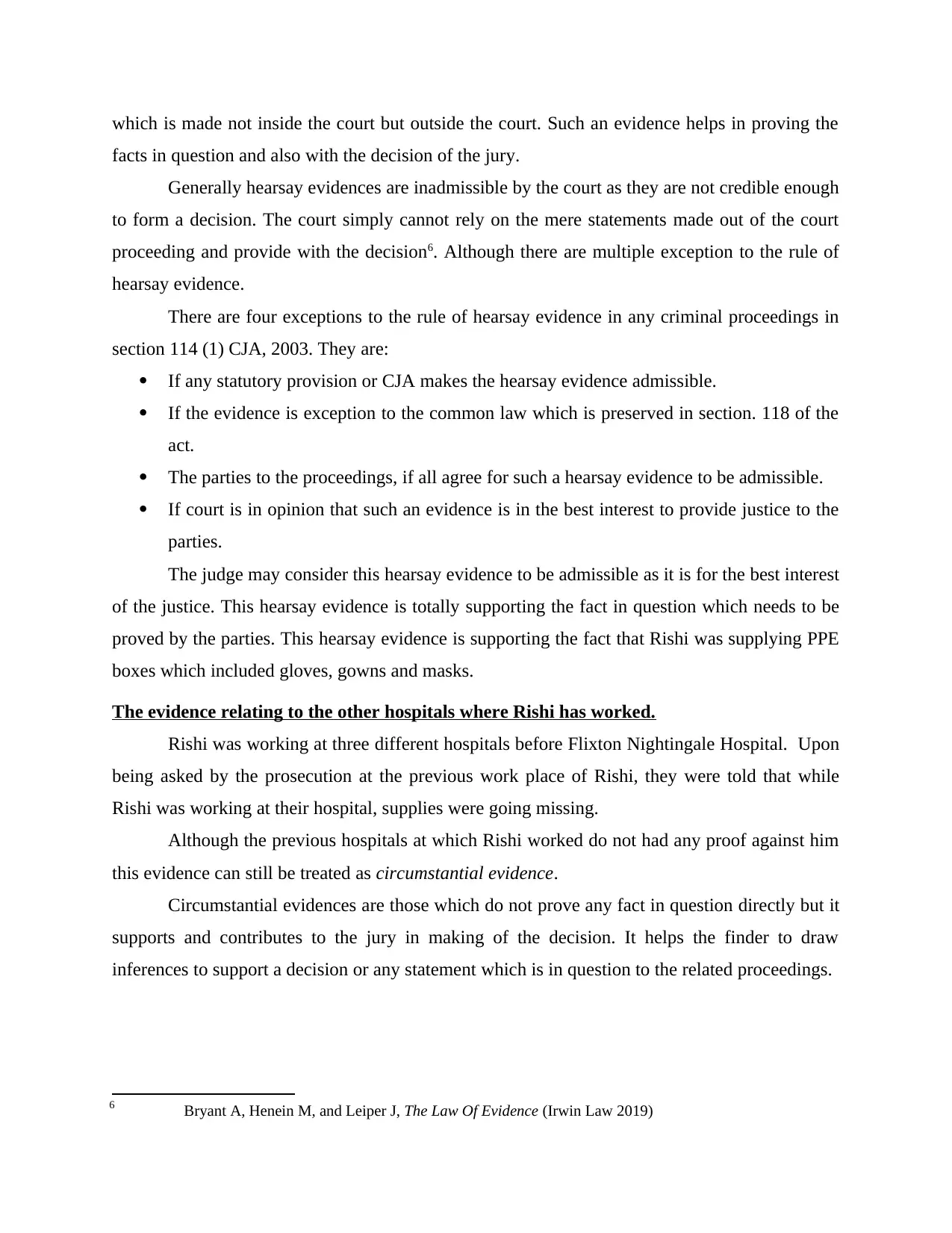
which is made not inside the court but outside the court. Such an evidence helps in proving the
facts in question and also with the decision of the jury.
Generally hearsay evidences are inadmissible by the court as they are not credible enough
to form a decision. The court simply cannot rely on the mere statements made out of the court
proceeding and provide with the decision6. Although there are multiple exception to the rule of
hearsay evidence.
There are four exceptions to the rule of hearsay evidence in any criminal proceedings in
section 114 (1) CJA, 2003. They are:
If any statutory provision or CJA makes the hearsay evidence admissible.
If the evidence is exception to the common law which is preserved in section. 118 of the
act.
The parties to the proceedings, if all agree for such a hearsay evidence to be admissible.
If court is in opinion that such an evidence is in the best interest to provide justice to the
parties.
The judge may consider this hearsay evidence to be admissible as it is for the best interest
of the justice. This hearsay evidence is totally supporting the fact in question which needs to be
proved by the parties. This hearsay evidence is supporting the fact that Rishi was supplying PPE
boxes which included gloves, gowns and masks.
The evidence relating to the other hospitals where Rishi has worked.
Rishi was working at three different hospitals before Flixton Nightingale Hospital. Upon
being asked by the prosecution at the previous work place of Rishi, they were told that while
Rishi was working at their hospital, supplies were going missing.
Although the previous hospitals at which Rishi worked do not had any proof against him
this evidence can still be treated as circumstantial evidence.
Circumstantial evidences are those which do not prove any fact in question directly but it
supports and contributes to the jury in making of the decision. It helps the finder to draw
inferences to support a decision or any statement which is in question to the related proceedings.
6 Bryant A, Henein M, and Leiper J, The Law Of Evidence (Irwin Law 2019)
facts in question and also with the decision of the jury.
Generally hearsay evidences are inadmissible by the court as they are not credible enough
to form a decision. The court simply cannot rely on the mere statements made out of the court
proceeding and provide with the decision6. Although there are multiple exception to the rule of
hearsay evidence.
There are four exceptions to the rule of hearsay evidence in any criminal proceedings in
section 114 (1) CJA, 2003. They are:
If any statutory provision or CJA makes the hearsay evidence admissible.
If the evidence is exception to the common law which is preserved in section. 118 of the
act.
The parties to the proceedings, if all agree for such a hearsay evidence to be admissible.
If court is in opinion that such an evidence is in the best interest to provide justice to the
parties.
The judge may consider this hearsay evidence to be admissible as it is for the best interest
of the justice. This hearsay evidence is totally supporting the fact in question which needs to be
proved by the parties. This hearsay evidence is supporting the fact that Rishi was supplying PPE
boxes which included gloves, gowns and masks.
The evidence relating to the other hospitals where Rishi has worked.
Rishi was working at three different hospitals before Flixton Nightingale Hospital. Upon
being asked by the prosecution at the previous work place of Rishi, they were told that while
Rishi was working at their hospital, supplies were going missing.
Although the previous hospitals at which Rishi worked do not had any proof against him
this evidence can still be treated as circumstantial evidence.
Circumstantial evidences are those which do not prove any fact in question directly but it
supports and contributes to the jury in making of the decision. It helps the finder to draw
inferences to support a decision or any statement which is in question to the related proceedings.
6 Bryant A, Henein M, and Leiper J, The Law Of Evidence (Irwin Law 2019)
Paraphrase This Document
Need a fresh take? Get an instant paraphrase of this document with our AI Paraphraser
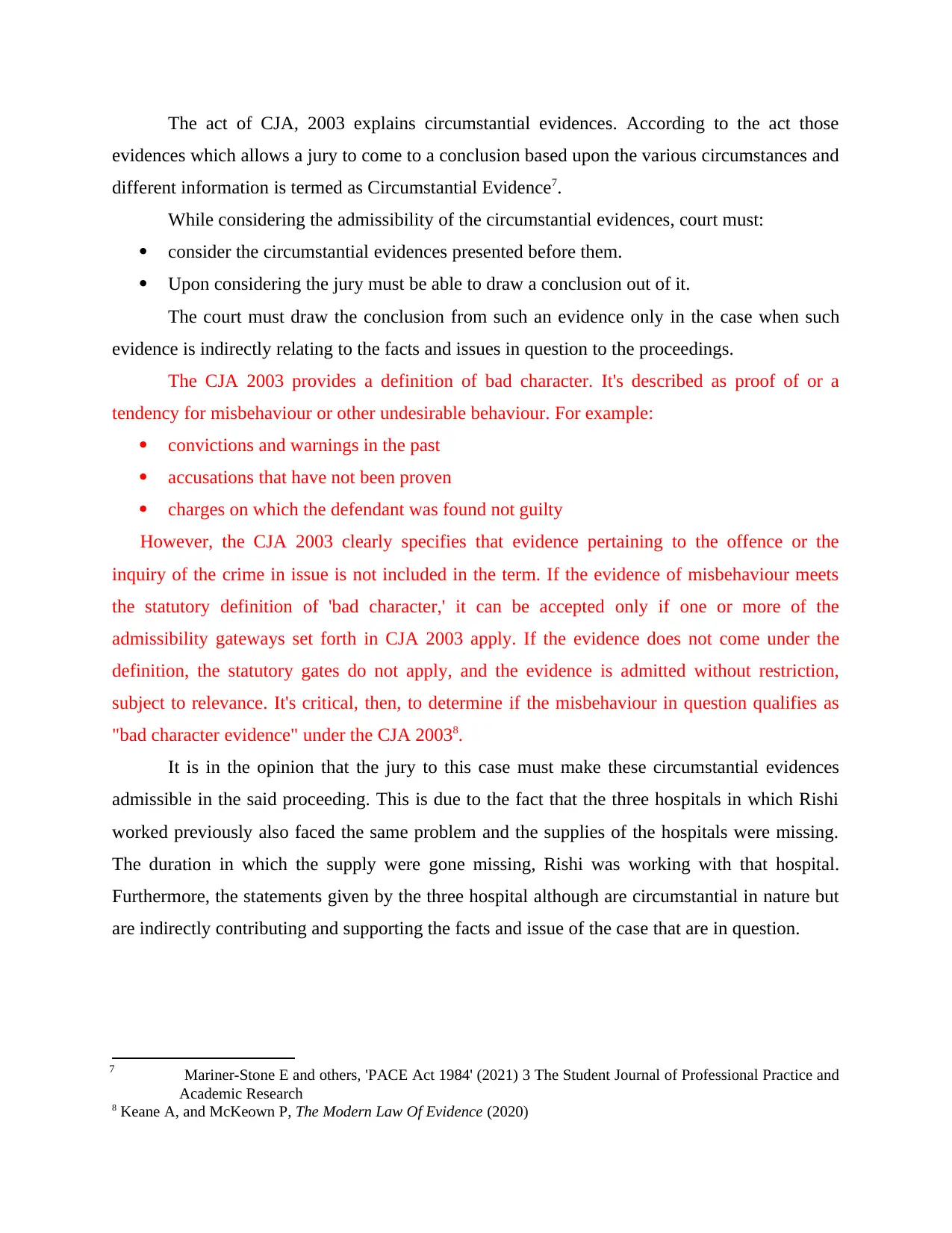
The act of CJA, 2003 explains circumstantial evidences. According to the act those
evidences which allows a jury to come to a conclusion based upon the various circumstances and
different information is termed as Circumstantial Evidence7.
While considering the admissibility of the circumstantial evidences, court must:
consider the circumstantial evidences presented before them.
Upon considering the jury must be able to draw a conclusion out of it.
The court must draw the conclusion from such an evidence only in the case when such
evidence is indirectly relating to the facts and issues in question to the proceedings.
The CJA 2003 provides a definition of bad character. It's described as proof of or a
tendency for misbehaviour or other undesirable behaviour. For example:
convictions and warnings in the past
accusations that have not been proven
charges on which the defendant was found not guilty
However, the CJA 2003 clearly specifies that evidence pertaining to the offence or the
inquiry of the crime in issue is not included in the term. If the evidence of misbehaviour meets
the statutory definition of 'bad character,' it can be accepted only if one or more of the
admissibility gateways set forth in CJA 2003 apply. If the evidence does not come under the
definition, the statutory gates do not apply, and the evidence is admitted without restriction,
subject to relevance. It's critical, then, to determine if the misbehaviour in question qualifies as
"bad character evidence" under the CJA 20038.
It is in the opinion that the jury to this case must make these circumstantial evidences
admissible in the said proceeding. This is due to the fact that the three hospitals in which Rishi
worked previously also faced the same problem and the supplies of the hospitals were missing.
The duration in which the supply were gone missing, Rishi was working with that hospital.
Furthermore, the statements given by the three hospital although are circumstantial in nature but
are indirectly contributing and supporting the facts and issue of the case that are in question.
7 Mariner-Stone E and others, 'PACE Act 1984' (2021) 3 The Student Journal of Professional Practice and
Academic Research
8 Keane A, and McKeown P, The Modern Law Of Evidence (2020)
evidences which allows a jury to come to a conclusion based upon the various circumstances and
different information is termed as Circumstantial Evidence7.
While considering the admissibility of the circumstantial evidences, court must:
consider the circumstantial evidences presented before them.
Upon considering the jury must be able to draw a conclusion out of it.
The court must draw the conclusion from such an evidence only in the case when such
evidence is indirectly relating to the facts and issues in question to the proceedings.
The CJA 2003 provides a definition of bad character. It's described as proof of or a
tendency for misbehaviour or other undesirable behaviour. For example:
convictions and warnings in the past
accusations that have not been proven
charges on which the defendant was found not guilty
However, the CJA 2003 clearly specifies that evidence pertaining to the offence or the
inquiry of the crime in issue is not included in the term. If the evidence of misbehaviour meets
the statutory definition of 'bad character,' it can be accepted only if one or more of the
admissibility gateways set forth in CJA 2003 apply. If the evidence does not come under the
definition, the statutory gates do not apply, and the evidence is admitted without restriction,
subject to relevance. It's critical, then, to determine if the misbehaviour in question qualifies as
"bad character evidence" under the CJA 20038.
It is in the opinion that the jury to this case must make these circumstantial evidences
admissible in the said proceeding. This is due to the fact that the three hospitals in which Rishi
worked previously also faced the same problem and the supplies of the hospitals were missing.
The duration in which the supply were gone missing, Rishi was working with that hospital.
Furthermore, the statements given by the three hospital although are circumstantial in nature but
are indirectly contributing and supporting the facts and issue of the case that are in question.
7 Mariner-Stone E and others, 'PACE Act 1984' (2021) 3 The Student Journal of Professional Practice and
Academic Research
8 Keane A, and McKeown P, The Modern Law Of Evidence (2020)
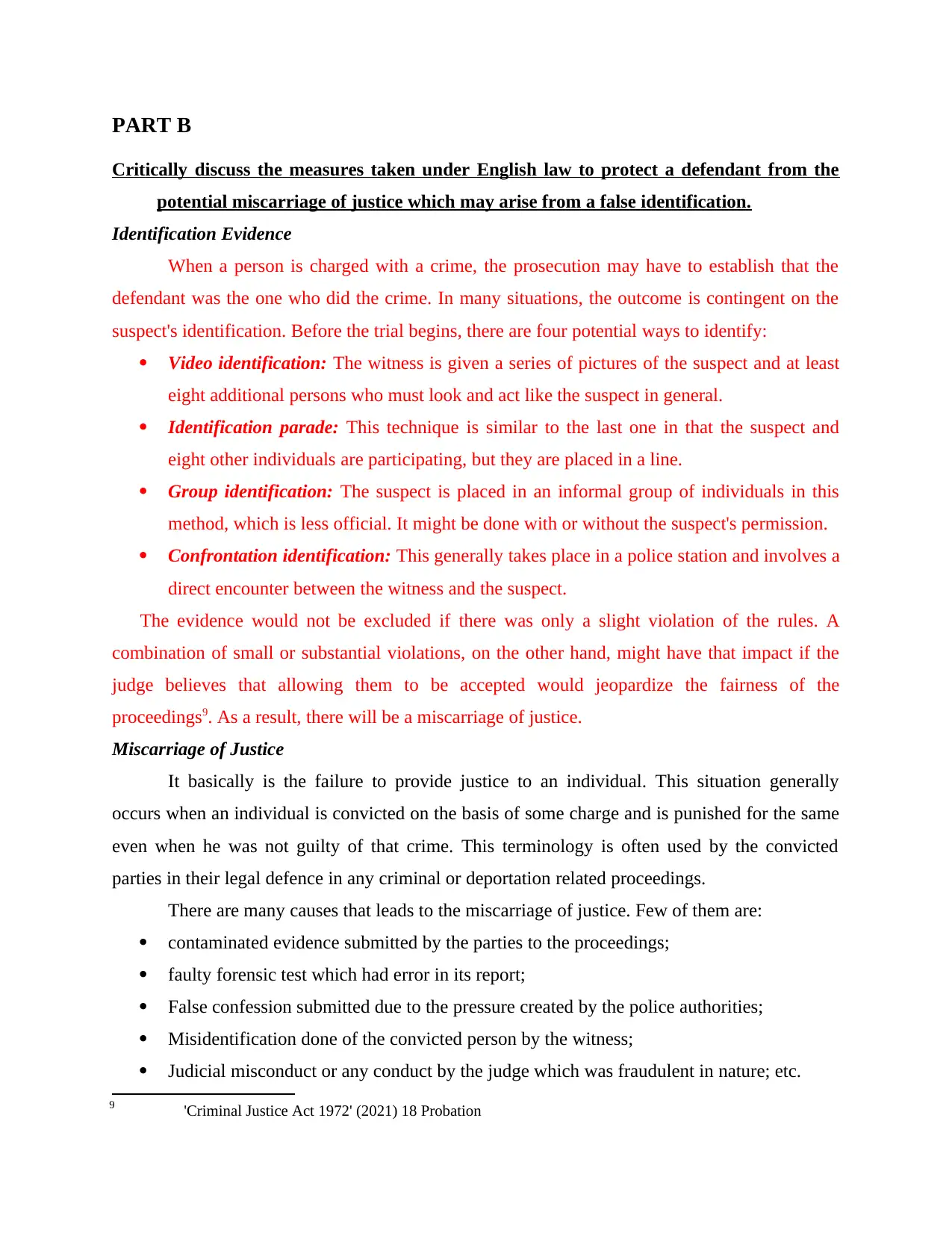
PART B
Critically discuss the measures taken under English law to protect a defendant from the
potential miscarriage of justice which may arise from a false identification.
Identification Evidence
When a person is charged with a crime, the prosecution may have to establish that the
defendant was the one who did the crime. In many situations, the outcome is contingent on the
suspect's identification. Before the trial begins, there are four potential ways to identify:
Video identification: The witness is given a series of pictures of the suspect and at least
eight additional persons who must look and act like the suspect in general.
Identification parade: This technique is similar to the last one in that the suspect and
eight other individuals are participating, but they are placed in a line.
Group identification: The suspect is placed in an informal group of individuals in this
method, which is less official. It might be done with or without the suspect's permission.
Confrontation identification: This generally takes place in a police station and involves a
direct encounter between the witness and the suspect.
The evidence would not be excluded if there was only a slight violation of the rules. A
combination of small or substantial violations, on the other hand, might have that impact if the
judge believes that allowing them to be accepted would jeopardize the fairness of the
proceedings9. As a result, there will be a miscarriage of justice.
Miscarriage of Justice
It basically is the failure to provide justice to an individual. This situation generally
occurs when an individual is convicted on the basis of some charge and is punished for the same
even when he was not guilty of that crime. This terminology is often used by the convicted
parties in their legal defence in any criminal or deportation related proceedings.
There are many causes that leads to the miscarriage of justice. Few of them are:
contaminated evidence submitted by the parties to the proceedings;
faulty forensic test which had error in its report;
False confession submitted due to the pressure created by the police authorities;
Misidentification done of the convicted person by the witness;
Judicial misconduct or any conduct by the judge which was fraudulent in nature; etc.
9 'Criminal Justice Act 1972' (2021) 18 Probation
Critically discuss the measures taken under English law to protect a defendant from the
potential miscarriage of justice which may arise from a false identification.
Identification Evidence
When a person is charged with a crime, the prosecution may have to establish that the
defendant was the one who did the crime. In many situations, the outcome is contingent on the
suspect's identification. Before the trial begins, there are four potential ways to identify:
Video identification: The witness is given a series of pictures of the suspect and at least
eight additional persons who must look and act like the suspect in general.
Identification parade: This technique is similar to the last one in that the suspect and
eight other individuals are participating, but they are placed in a line.
Group identification: The suspect is placed in an informal group of individuals in this
method, which is less official. It might be done with or without the suspect's permission.
Confrontation identification: This generally takes place in a police station and involves a
direct encounter between the witness and the suspect.
The evidence would not be excluded if there was only a slight violation of the rules. A
combination of small or substantial violations, on the other hand, might have that impact if the
judge believes that allowing them to be accepted would jeopardize the fairness of the
proceedings9. As a result, there will be a miscarriage of justice.
Miscarriage of Justice
It basically is the failure to provide justice to an individual. This situation generally
occurs when an individual is convicted on the basis of some charge and is punished for the same
even when he was not guilty of that crime. This terminology is often used by the convicted
parties in their legal defence in any criminal or deportation related proceedings.
There are many causes that leads to the miscarriage of justice. Few of them are:
contaminated evidence submitted by the parties to the proceedings;
faulty forensic test which had error in its report;
False confession submitted due to the pressure created by the police authorities;
Misidentification done of the convicted person by the witness;
Judicial misconduct or any conduct by the judge which was fraudulent in nature; etc.
9 'Criminal Justice Act 1972' (2021) 18 Probation
⊘ This is a preview!⊘
Do you want full access?
Subscribe today to unlock all pages.

Trusted by 1+ million students worldwide
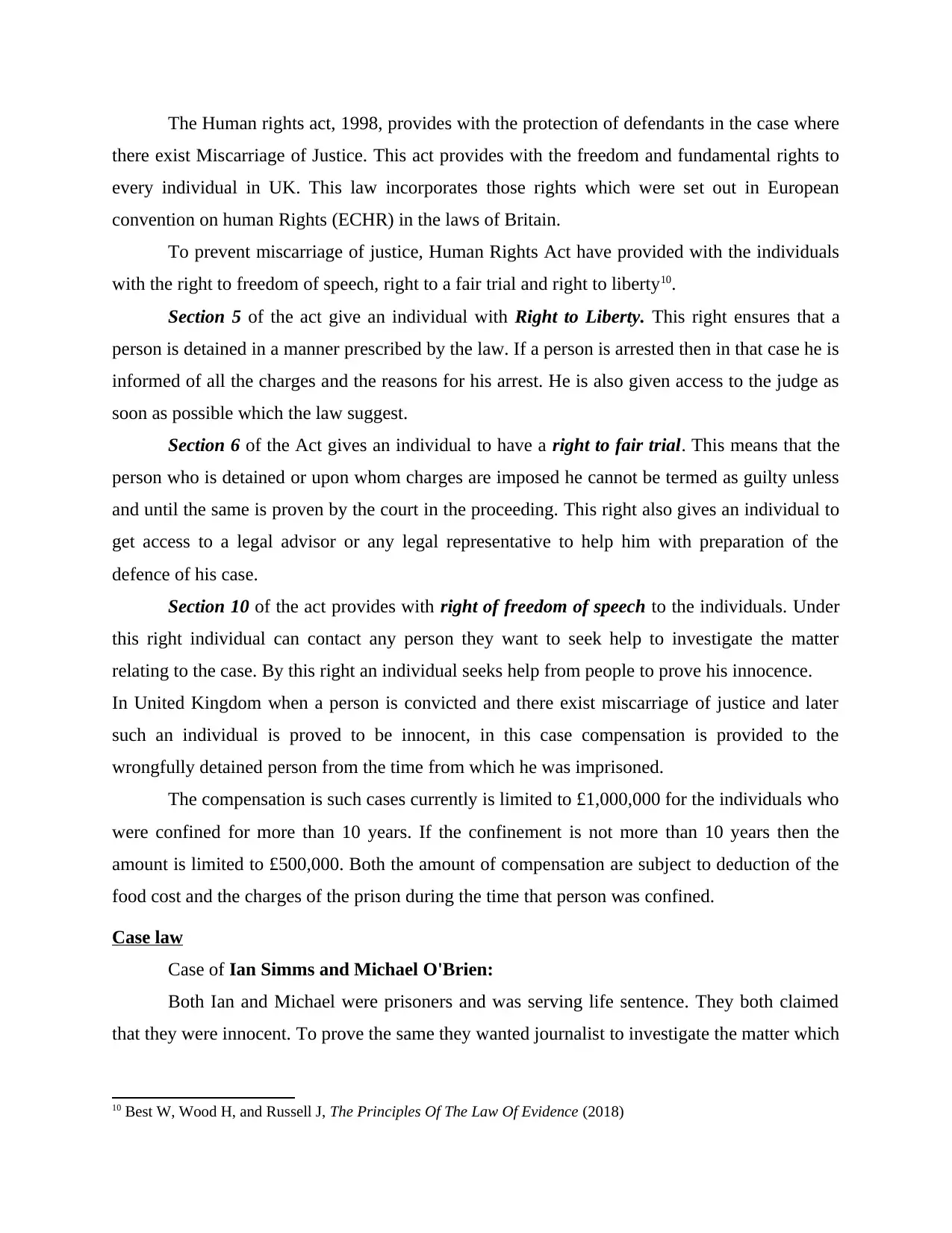
The Human rights act, 1998, provides with the protection of defendants in the case where
there exist Miscarriage of Justice. This act provides with the freedom and fundamental rights to
every individual in UK. This law incorporates those rights which were set out in European
convention on human Rights (ECHR) in the laws of Britain.
To prevent miscarriage of justice, Human Rights Act have provided with the individuals
with the right to freedom of speech, right to a fair trial and right to liberty10.
Section 5 of the act give an individual with Right to Liberty. This right ensures that a
person is detained in a manner prescribed by the law. If a person is arrested then in that case he is
informed of all the charges and the reasons for his arrest. He is also given access to the judge as
soon as possible which the law suggest.
Section 6 of the Act gives an individual to have a right to fair trial. This means that the
person who is detained or upon whom charges are imposed he cannot be termed as guilty unless
and until the same is proven by the court in the proceeding. This right also gives an individual to
get access to a legal advisor or any legal representative to help him with preparation of the
defence of his case.
Section 10 of the act provides with right of freedom of speech to the individuals. Under
this right individual can contact any person they want to seek help to investigate the matter
relating to the case. By this right an individual seeks help from people to prove his innocence.
In United Kingdom when a person is convicted and there exist miscarriage of justice and later
such an individual is proved to be innocent, in this case compensation is provided to the
wrongfully detained person from the time from which he was imprisoned.
The compensation is such cases currently is limited to £1,000,000 for the individuals who
were confined for more than 10 years. If the confinement is not more than 10 years then the
amount is limited to £500,000. Both the amount of compensation are subject to deduction of the
food cost and the charges of the prison during the time that person was confined.
Case law
Case of Ian Simms and Michael O'Brien:
Both Ian and Michael were prisoners and was serving life sentence. They both claimed
that they were innocent. To prove the same they wanted journalist to investigate the matter which
10 Best W, Wood H, and Russell J, The Principles Of The Law Of Evidence (2018)
there exist Miscarriage of Justice. This act provides with the freedom and fundamental rights to
every individual in UK. This law incorporates those rights which were set out in European
convention on human Rights (ECHR) in the laws of Britain.
To prevent miscarriage of justice, Human Rights Act have provided with the individuals
with the right to freedom of speech, right to a fair trial and right to liberty10.
Section 5 of the act give an individual with Right to Liberty. This right ensures that a
person is detained in a manner prescribed by the law. If a person is arrested then in that case he is
informed of all the charges and the reasons for his arrest. He is also given access to the judge as
soon as possible which the law suggest.
Section 6 of the Act gives an individual to have a right to fair trial. This means that the
person who is detained or upon whom charges are imposed he cannot be termed as guilty unless
and until the same is proven by the court in the proceeding. This right also gives an individual to
get access to a legal advisor or any legal representative to help him with preparation of the
defence of his case.
Section 10 of the act provides with right of freedom of speech to the individuals. Under
this right individual can contact any person they want to seek help to investigate the matter
relating to the case. By this right an individual seeks help from people to prove his innocence.
In United Kingdom when a person is convicted and there exist miscarriage of justice and later
such an individual is proved to be innocent, in this case compensation is provided to the
wrongfully detained person from the time from which he was imprisoned.
The compensation is such cases currently is limited to £1,000,000 for the individuals who
were confined for more than 10 years. If the confinement is not more than 10 years then the
amount is limited to £500,000. Both the amount of compensation are subject to deduction of the
food cost and the charges of the prison during the time that person was confined.
Case law
Case of Ian Simms and Michael O'Brien:
Both Ian and Michael were prisoners and was serving life sentence. They both claimed
that they were innocent. To prove the same they wanted journalist to investigate the matter which
10 Best W, Wood H, and Russell J, The Principles Of The Law Of Evidence (2018)
Paraphrase This Document
Need a fresh take? Get an instant paraphrase of this document with our AI Paraphraser
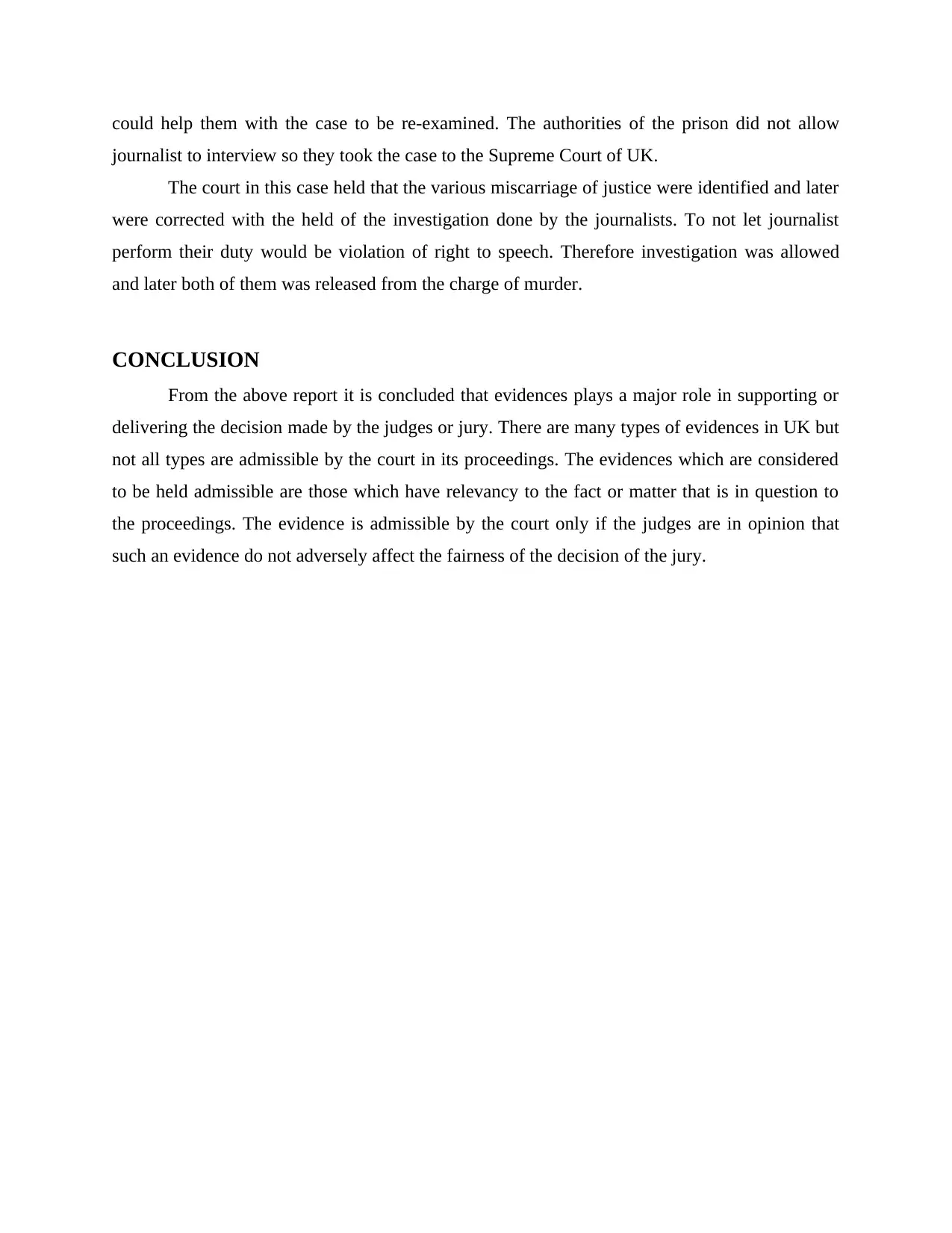
could help them with the case to be re-examined. The authorities of the prison did not allow
journalist to interview so they took the case to the Supreme Court of UK.
The court in this case held that the various miscarriage of justice were identified and later
were corrected with the held of the investigation done by the journalists. To not let journalist
perform their duty would be violation of right to speech. Therefore investigation was allowed
and later both of them was released from the charge of murder.
CONCLUSION
From the above report it is concluded that evidences plays a major role in supporting or
delivering the decision made by the judges or jury. There are many types of evidences in UK but
not all types are admissible by the court in its proceedings. The evidences which are considered
to be held admissible are those which have relevancy to the fact or matter that is in question to
the proceedings. The evidence is admissible by the court only if the judges are in opinion that
such an evidence do not adversely affect the fairness of the decision of the jury.
journalist to interview so they took the case to the Supreme Court of UK.
The court in this case held that the various miscarriage of justice were identified and later
were corrected with the held of the investigation done by the journalists. To not let journalist
perform their duty would be violation of right to speech. Therefore investigation was allowed
and later both of them was released from the charge of murder.
CONCLUSION
From the above report it is concluded that evidences plays a major role in supporting or
delivering the decision made by the judges or jury. There are many types of evidences in UK but
not all types are admissible by the court in its proceedings. The evidences which are considered
to be held admissible are those which have relevancy to the fact or matter that is in question to
the proceedings. The evidence is admissible by the court only if the judges are in opinion that
such an evidence do not adversely affect the fairness of the decision of the jury.
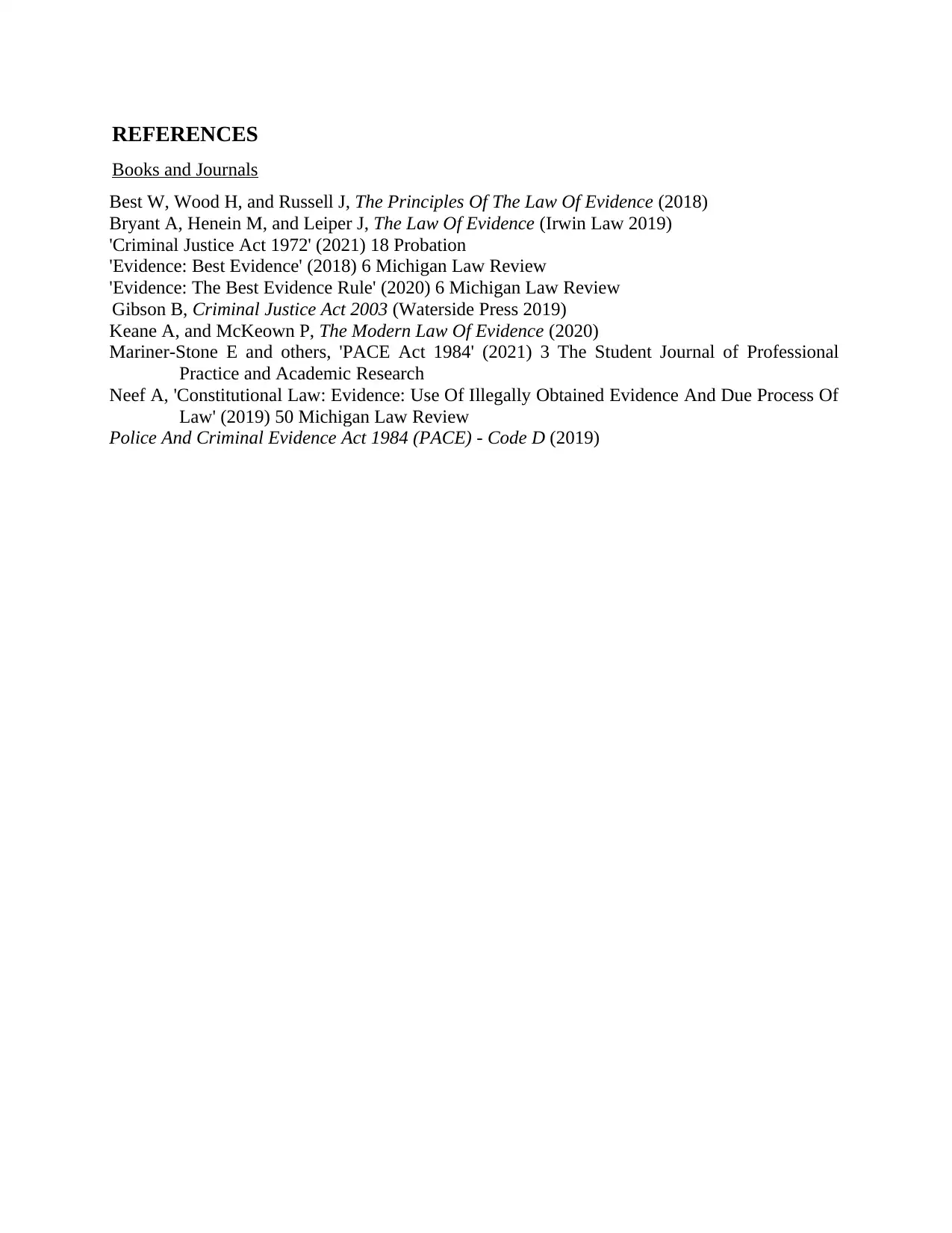
REFERENCES
Books and Journals
Best W, Wood H, and Russell J, The Principles Of The Law Of Evidence (2018)
Bryant A, Henein M, and Leiper J, The Law Of Evidence (Irwin Law 2019)
'Criminal Justice Act 1972' (2021) 18 Probation
'Evidence: Best Evidence' (2018) 6 Michigan Law Review
'Evidence: The Best Evidence Rule' (2020) 6 Michigan Law Review
Gibson B, Criminal Justice Act 2003 (Waterside Press 2019)
Keane A, and McKeown P, The Modern Law Of Evidence (2020)
Mariner-Stone E and others, 'PACE Act 1984' (2021) 3 The Student Journal of Professional
Practice and Academic Research
Neef A, 'Constitutional Law: Evidence: Use Of Illegally Obtained Evidence And Due Process Of
Law' (2019) 50 Michigan Law Review
Police And Criminal Evidence Act 1984 (PACE) - Code D (2019)
Books and Journals
Best W, Wood H, and Russell J, The Principles Of The Law Of Evidence (2018)
Bryant A, Henein M, and Leiper J, The Law Of Evidence (Irwin Law 2019)
'Criminal Justice Act 1972' (2021) 18 Probation
'Evidence: Best Evidence' (2018) 6 Michigan Law Review
'Evidence: The Best Evidence Rule' (2020) 6 Michigan Law Review
Gibson B, Criminal Justice Act 2003 (Waterside Press 2019)
Keane A, and McKeown P, The Modern Law Of Evidence (2020)
Mariner-Stone E and others, 'PACE Act 1984' (2021) 3 The Student Journal of Professional
Practice and Academic Research
Neef A, 'Constitutional Law: Evidence: Use Of Illegally Obtained Evidence And Due Process Of
Law' (2019) 50 Michigan Law Review
Police And Criminal Evidence Act 1984 (PACE) - Code D (2019)
⊘ This is a preview!⊘
Do you want full access?
Subscribe today to unlock all pages.

Trusted by 1+ million students worldwide
1 out of 12
Related Documents
Your All-in-One AI-Powered Toolkit for Academic Success.
+13062052269
info@desklib.com
Available 24*7 on WhatsApp / Email
![[object Object]](/_next/static/media/star-bottom.7253800d.svg)
Unlock your academic potential
Copyright © 2020–2025 A2Z Services. All Rights Reserved. Developed and managed by ZUCOL.





